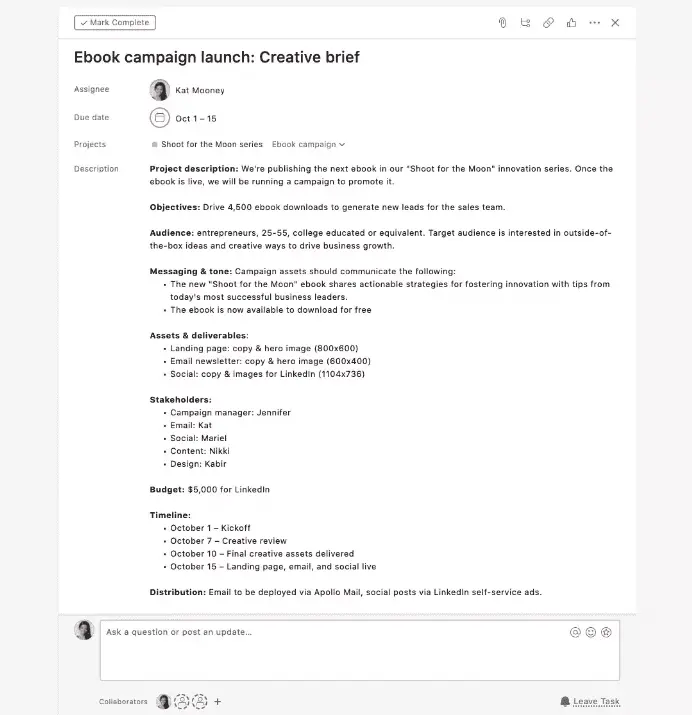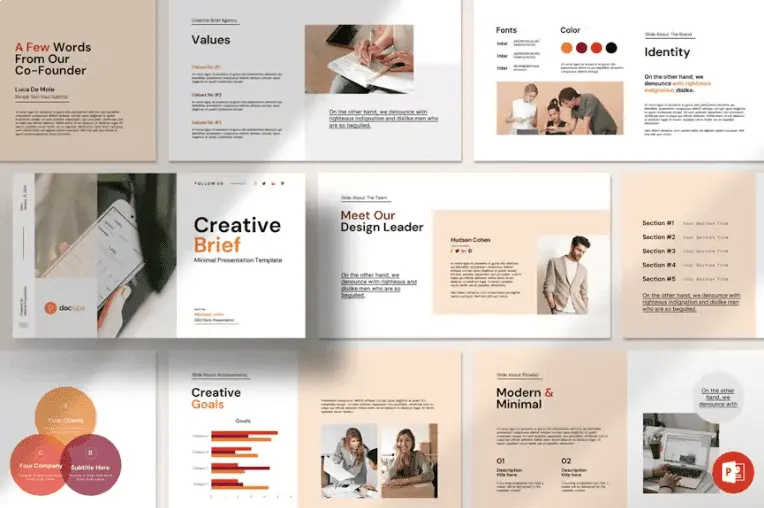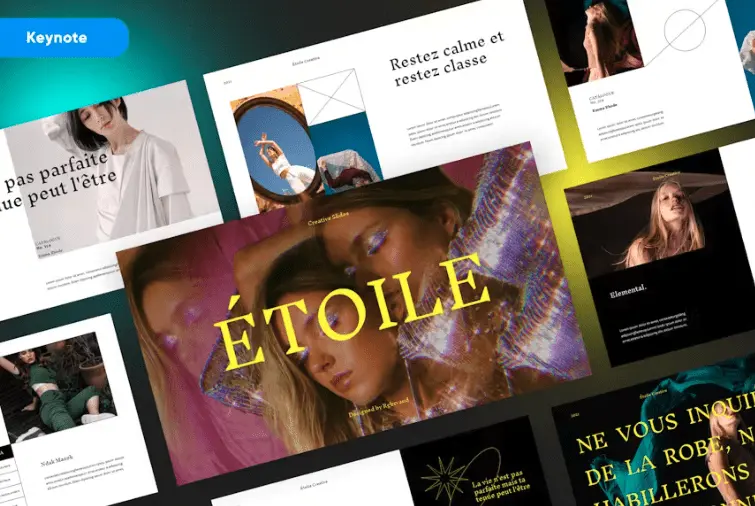In this article, you’ll learn:
When it comes to working with designers, something that can make or break a project is the creative brief. A well-crafted brief sets the foundation for successful collaboration, helps designers clearly understand the project goals, and can deliver exceptional results.
Let’s review the secrets to crafting the ultimate creative brief for design success. This guide will teach you how to gather insights from various sources and perspectives.
Creative Brief: Purpose and Components
A creative brief is a document that recaps the key objectives, goals, guidelines, and constraints of a project that needs design. The primary purpose of this document is to provide a clear and concise set of instructions and insights to the design team members. Why is this fundamental before starting a project? This is how they can understand the project vision and goals, interpret them creatively, and deliver a successful outcome.
Ultimately, a well-crafted creative brief ensures everyone involved is on the same page, and things run smoothly and effectively.
If you’re unsure how to start writing a creative brief, you can use this example from Asana, a basic template that can work as a starting point.

Keep in mind that the essential components for this kind of brief are:
- Project objectives and goals establish the overall project vision and theme and enable the design team to envision the final outcome.
- Target audience and market research provide color into the target audience's demographics, preferences, and habits.
- Competitive analysis adds depth and understanding of the competition, what works and what doesn't.
- Project scope and deliverables help the design team understand how the project fits the bigger picture.
- Timelines and deadlines guarantee that the work is on schedule.
- Budget considerations are paramount to establishing realistic goals and balancing cost-effectiveness with quality.

You can see some of these components in the example above. The creative brief, with each component tailored to the project's goals, will be a powerful tool for the design team and result in successful campaigns, presentations, or other visual asset-based creations. H2. How to Make a Creative Brief
These are the main steps in putting a creative brief together:
- Name the project
Provide a concise and descriptive name for the project to help set the tone and direction that. This will give your team an idea of what type of project they’ll be working on.
- Write about the brand and summarize the project
Define brand identity, values, and positioning. Summarize the project scope, purpose, and desired outcomes.
- Define the project objective
Clearly communicate the specific goals and objectives of the project to guide decision-making.
- Describe target audience
Identify the target audience's demographic, psychographic, and behavioral characteristics to tailor the design accordingly.
- Understand your competition
Analyze competitors to understand the market landscape and differentiate the project from competitors.
- Define a key message
Determine the core message or theme the design should communicate effectively to the audience.
- Choose the key benefit for the audience
Identify the primary value proposition or benefit that the audience should associate with the project.
- Determine the best call to action
Clearly outline the desired action you want the audience to take after engaging with the design.
- Draft the distribution plan
Plan how you will distribute the design across various channels to reach your target audience.
- Share the brief with stakeholders
Collaborate with key stakeholders to review and approve the creative brief to provide alignment and understanding of project goals and expectations.
Now that we have gone through key steps, let’s go through best practices, tips, and actions to create the best design brief possible.
Understanding and Communicating the Vision
A clear vision is essential for successful design projects as it provides a defined direction and purpose. It helps align the creative team's efforts, allows for effective decision-making, and ensures that the result reflects the intended objectives.
Having a clear vision will guide the design process, foster creativity, and ultimately lead to creating impactful and cohesive designs.
To effectively communicate this vision to the design team, you can benefit from the following techniques:
1. Visual references and mood boards

Visual references and mood boards can effectively convey the project's desired aesthetic, style, and atmosphere.
A visual reference or mood board can vividly depict the intended direction by compiling images, color palettes, typography samples, and other visual elements. This helps the design team to align their creative vision with the desired outcome, which results in a focused and cohesive approach.
Digital asset management tools and project management software can come in handy when sharing various assets with your team members while you’re creating the first mood boards and visual references.
2. Verbal and written explanations
Clear and concise verbal explanations, supplemented by written documentation, help provide detailed instructions and context to the design team. They can include specific details about the project scope, target audience, brand guidelines, and other relevant information that helps the creative team understand and implement the vision effectively.
3. Collaborative brainstorming sessions
Furthermore, collaborative creative brainstorming sessions are valuable for generating ideas and exploring possibilities. The design team can collectively develop innovative concepts and solutions that align with the project's vision through such sessions. This joint approach encourages open communication, active participation, and integration of diverse perspectives.
Creative brainstorming sessions can take various formats, such as group discussions, idea sharing, sketching, or even using digital collaboration tools. These meetings foster creativity, facilitate problem-solving, and allow refining and combining ideas to create a stronger vision.
Tailoring the Brief to the Design Team
Before creating the actual brief, consider your team’s working style to create an environment for optimal creativity, productivity, and collaboration.
- Recognize the team's unique strengths and preferences. When you prioritize their expertise and abilities, people feel more confident sharing, suggesting, and providing feedback.
- Consider the team's working styles and creative processes. The process will flow better if you’re flexible and can accommodate their preferred methods.
- Use effective communication channels and methods to foster transparent and open dialogue. Having an open conversation will help everyone stay on the same page.
Defining Project Objectives and Target Audience
When defining the objectives before creative briefing, it is essential to identify the project's specific goals and desired outcomes.
- Clarify what you aim to achieve. This helps set a clear direction for the creative process. Simultaneously, it’s crucial to understand the target audience.
- Define your intended audience's demographics, psychographics, and behavior patterns.
- Learn insights into their preferences, interests, and needs. You can adjust the design to resonate with them effectively.
Once you set your project’s objectives and understand the target audience, you put a strong foundation for creating a creative brief.
Use the SMART Method to Set Your Goals
If you’re unsure of where to begin, setting SMART goals is an effective way to ensure clarity, focus, and accountability in goal setting. Here's a step-by-step guide on how to set SMART goals:
- Specific
Clearly define the goal by answering the questions: What exactly do you want to achieve? Why is the goal relevant? When and where is the goal to be achieved? Which resources will you use? Who are the stakeholders? Be precise and avoid vague language. For example, instead of "increase sales," specify a specific percentage increase, like "increase sales by 20%."
- Measurable
Establish criteria to track your progress. Identify specific metrics or indicators that will measure your success. This allows you to assess your progress objectively. For instance, "acquire 100 new customers in Q3."
- Achievable
Make sure that it is a realistic goal. Consider the resources, skills, and time frame available to achieve the goal. Set challenging but doable objectives. Evaluate the feasibility based on your current situation and your constraints.
- Relevant
Align the goal with your objectives and ensure it is relevant to your broader plans and aspirations. Consider the relevance of the goal to your organization or personal growth. It should have a meaningful impact and contribute to your desired outcomes.
- Time-based
Set a clear timeline or deadline for achieving the goal. This helps create urgency and provides a sense of focus and accountability. Assign dates or time frames to different milestones or actions to keep yourself on track. For example, "complete the project by the end of March."
Conducting a Comprehensive Competitive Analysis
A competitive analysis for a creative brief involves thorough research into the competition and industry trends.
It’s important to:
- Analyze your competitors' design approaches, branding strategies, and visual identities so you can identify successful tactics and potential gaps in the market.
- Analyze industry trends, so you stay current and innovative in your design solutions.
- Leverage insights from this analysis to differentiate your design project by offering unique value propositions that stand out.
Establishing Project Scope and Deliverables
This is what you can do to ask for deliverables in an effective, realistic way:
- Determine the scope of the project and any limitations, such as budget or time restrictions.
- Clarify the deliverables and expectations by clearly defining what you’ll need to produce and the specific requirements for each deliverable.
- Collaborate with the design team to establish realistic goals and confirm everyone is aligned on the project scope and deliverables. This promotes effective communication, minimizes misunderstandings, and sets realistic expectations for all stakeholders involved.
Setting Realistic Timelines and Deadlines for Your Design Team
Using project management tools like Asana, Monday, or ClickUp can help with this.
The following are factors to consider when setting specific time frames:
- Consider the project complexity and available resources to determine each task's duration.
- Break the project into milestones. This helps track progress and ensures timely completion.
- Communicate clear expectations and deliverables to the design team, aligning everyone's understanding of the timeline.
- Allow for flexibility by building in buffer time for unexpected delays or revisions. Regularly communicate and check in with the creative team to verify they have the necessary resources and support.
When you create a brief with all these factors in mind and establish realistic timelines, you create a framework that promotes productivity, avoids burnout, and leads to successful design outcomes.
Budget Considerations for Design Success
Understanding the budget's impact on design quality is essential to make informed decisions. Additionally, it's important to:
- Prioritize key design elements within budget constraints and identify the most critical aspects that align with project goals.
- Collaborate with the design team; their expertise can help identify cost-effective solutions. For example, choosing an all-in-one creative subscription could be better than paying for individual licenses.
- Explore alternative materials, production methods, or leveraging existing assets. The team can create high-quality designs that meet both aesthetic and budget requirements.
- Focus on effective budget management, so you deliver impactful designs while maximizing resources and achieving desired outcomes.
Wrapping Up
Crafting the ultimate creative brief is crucial for design success. It sets the foundation for a project, providing clarity, direction, and alignment for the design team.
A well-crafted brief outlines the project goals, target audience, brand guidelines, and desired outcomes. It inspires creativity, guides decision-making, and ensures effective communication between stakeholders and the creative team.
If you follow the strategies we’ve discussed, you can create impactful and purposeful designs. Embrace the power of an outstanding brief in your design projects to achieve extraordinary results.
Did you enjoy this article? Give Pics.io a try — or book a demo with us, and we'll be happy to answer any of your questions.




